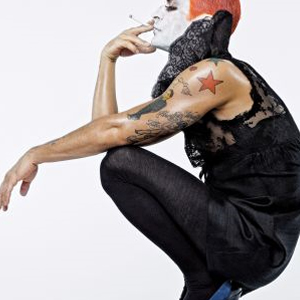Marc Jacobs is a fashion designer who’s changing the meaning of that job. He does what an ordinary superdesigner does, i.e., create fashion-changing clothes for his own labels and for a great French house, but he also does so much more. His collaborations with Stephen Sprouse, Takashi Murakami, and Richard Prince have shaken things up in both the fashion and the art worlds. Not to mention advertising that looks like art or boutiques that feel like clubs. Andy Warhol used to talk about the best art being business art. And it would be hard to find someone who has done more to apply an artist’s thinking to running a creative big business than Marc Jacobs.
GLENN O’BRIEN: You’re going to be our Andy Warhol?
MARC JACOBS: I feel really weird about it to be honest, but I guess it’s what I’m gonna do.
GO: You know why we thought of it? It’s because you’ve kind of redefined things in the same way that he did.
MJ: Well, I didn’t mean to. [both laugh]
GO: It’s not your fault!
MJ: It’s not my fault! I just have interests outside of the superficial world of fashion. [laughs]
GO: That’s different for someone in your line of work. You know, mixing up art and fashion is something kind of new.
MJ: No. No, in fact, that’s why I did it in the first place, because it was kind of old, and I thought it was missing. Do you want me to just break right into the whole-[laughing]
GO: Please.
MJ: I mean, I’m not shy when it comes to talking, so, unlike Andy, you won’t get a lot of, "Um, do you think so? Really?" You won’t get a lot of one-word answers.
GO: "Oh, gee!"
MJ: "Oh, gee!"
GO: "Oh, really?"
MJ: I came to Paris when I was hired by Mr. [Bernard] Arnault to work here at Louis Vuitton, and looking at myself in this position, I just thought of myself as this New Yorker in Paris. I started to think in romantic terms, and I always thought back to the time of Schiaparelli and Chanel and Cocteau, when all of these creative people seemed to be doing things together. They were influenced by the work of Pablo Picasso or Salvador Dalí, and fashion and art had a dance, you know? Well, there’s actually two parts to this. . . . I talk a lot, and it doesn’t often make sequential sense.
GO: No, I prefer when you go out of sequence.
MJ: Okay, so I’m gonna go back and forth. I was looking to rent an apartment when I first got here. Charlotte Gainsbourg had just had a baby and she was sitting in the bedroom breastfeeding, and I was looking at her apartment, and, in the corner, she had a trunk, a Louis Vuitton trunk that had been painted black. But a lot of the black had come off. It was her dad’s-that being Serge-and he had painted it black. And for some reason, that triggered me thinking about my favorite work of art ever, which is L.H.O.O.Q. by [Marcel] Duchamp. And I thought, This Vuitton monogram is sort of the Mona Lisa of this company.
GO: Yeah.
MJ: And what I wanted to do, in the same way Serge had done, was deface it. The same way that Duchamp had done with L.H.O.O.Q., by putting this moustache on [the Mona Lisa] and making it something hipper, a little bit anarchic, and just cooler. And by defacing something, making it new again. And so I had this idea of asking Stephen [Sprouse] to come here and do graffiti on top of it.
GO: Yeah.
MJ: And I was so pleased with that particular collaboration, being such a big fan of Stephen’s. I always adored him as an artist and as a fashion designer. I got to become friendly with him through the time we spent together here in the office in Paris. I just felt like it all made sense. My name isn’t Louis Vuitton. This company has this legendary status. It’s a part of what I romanticized about life in Paris as a kid who studied fashion. I looked up to these people who I’d never met. Without any kind of real ego on my part, I just thought, I’m going to approach the people I admire and see if they want to do something together. And that’s how it all started.
GO: It was amazing, the success of those bags.
MJ: It was really amazing. And at the time it was a very different set of circumstances here at Vuitton. I basically broke the rules. I was told point-blank that I couldn’t change the canvas or do anything to it. And I got fed up with doing what I thought would please the head of communications. I got tired of playing by the rules. And I thought, The only time I’ve ever made a difference, and the only time anything ever changes, is really when you’re respectful and disrespectful at the same time. Just as I’d been fired for the grunge collection I did at Perry Ellis, I thought, Whoa, you know, this is what I think we should be doing, and we’re going to send it out anyway . . . There was a different president here at Vuitton, and a different head of communications. But the press responded so well, and there was such fervor for these bags. They were knocked off immediately. So I forced the company into getting behind something that they didn’t want me to do in the beginning. It was the public that really said, "This is what we wanna see. This is what makes an old thing that our mothers and grandmothers and grandfathers and great-grandparents carried into something that we actually want now." And so, there was a lesson in this for me. Not that I really needed to learn it, because it was doing what I instinctively wanted to do.
GO: But it’s even bolder than what you did at Perry Ellis. When you’re messing with the logo, it’s like adding on a wing to Notre Dame.
MJ: The only comparison I’m making is that the collection that I’m most proud of from Perry Ellis was that collection. It was called Grunge.
GO: Right.
MJ: I was told my first collection wasn’t Perry Ellis enough. The second one was too lady-ish. So, what I learned was that the work that I was proudest of was when I stopped listening to everybody and just responded to what was in my heart. I was listening to this music and looking at the work of photographers and running around with a bunch of models who were less than conventional in terms of their beauty. And so, just as Grunge felt very right, even though it was what I was not supposed to be doing for the image of Perry Ellis, it’s what produced work that has some resonance or meant something in terms of fashion.
GO: When I met Stephen, he was assisting Halston. I was just in Pittsburgh at the archives of the Warhol Museum, and we dug out of a box a collaboration between Andy and Halston. It was a bathrobe with money silk-screened on it.
MJ: Oh, really?
GO: It was $100 bills or something. Apparently they actually put this out, and the Treasury Department came after Halston.
MJ: That’s funny, because I wanted to do money. Last season, because of all the recession talk, I wanted to do a $9 bill print. They sent the print down to our legal department, who told me that I couldn’t reproduce U.S. tender if it was the actual size, and I had to make it noticeably larger or smaller.
GO: Yeah, that’s how they get away with those rolling papers.
MJ: Yeah! That’s how they do it! And it’s funny, we’re working with Jeffrey Deitch on this big retrospective of Stephen’s work.
GO: He never really got the credit due him as an artist. He had this amazing show at Patrick Fox, the show with these crucified Iggy Pops-
MJ: Yeah! That’s one of the ones I have. On a canvas stretched on a crucifix shape.
GO: I only have it on a T-shirt. So how did you get the idea to work with Murakami?
MJ: Well, again, it was such a whim. My mind absorbs things in a funny way. I’m on planes quite a bit and I always take stacks and stacks of magazines and I go through them and tear pages out and fold them up, and they get stuck at the bottom of my backpack or whatever. I’d seen an article about Takashi. I just remember the graphic. It was the DOB character, a funny Mickey Mouse-type thing. I didn’t really read the article; I was just drawn to the graphic. A couple months later there was another magazine and a different graphic, but again I tore it out-and I wasn’t aware that it was the same artist. Then I received a Christie’s catalogue and on the back cover there was a statue of Hiropon-that’s the female figure that’s squirting milk out of her breasts in an arc. I looked at the statue and then I remember going online and reading the essay that accompanied it. It talked about Takashi’s references to Warhol and the Factory, and how Takashi credited the artists he worked with. I lived not far from the Cartier Foundation, so I walked by there one weekend, and there was an enormous show of his work. I went on a Saturday and then on Monday I came to the office and I just thought, I wonder if that guy would ever be interested in collaborating on something for Vuitton? So we sent him an e-mail, and he was really interested. But my e-mail was so vague: "I would love to know if you’d be interested in coming and having a meeting . . ." A few days later, he arrived with a team of Japanese assistants and the other artists he works with. They came into my office-my dog was there, the other designers I work with were there, there was stuff all over the walls. He just started taking pictures and making videotapes, and then we started talking. Neither one of us was very specific about what we wanted out of this thing, but we decided that we would do something together.
Takashi was so pleased with what we had done that he then had a show at Marianne Boesky Gallery where he showed his paintings, which were inspired by the work that we had done together. He had an actual art show of work that he had done after seeing the fashion show.
GO: I think that the art critics raised their eyebrows at the handbags. But when they saw the logoed canvases, it drove them crazy.
MJ: Art critics are like every other critic. I mean, I’m not judging. Well, I guess I am judging.
GO: It’s okay to judge the judges.
MJ: I think something happens with age. And I find this really a lot in what I read from certain art critics: For people who are all about change-people who are supposed to be intellectually and culturally drawn to the idea of change and how the voice of a creative person affects the world on a bigger scale than just the canvas-I would expect a person in that position to have that open mind. It’s only a sign of age that they become so locked in their own rules that they forget that this is what it’s all about. Whether you like Damien Hirst’s work, whether you like Takashi’s work or Jeff Koons’s work or Richard Prince’s work or whatever great artist you’re talking about, they are doing something that has changed the perceptions of today’s culture. Whether you like it or not, there’s a validity to it. For all the critics who made fun of this installation of a Vuitton shop within Takashi’s MOCA exhibition . . . I saw it as like Martin Kippenberger’s subway grate, you know? It challenged this sort of categorizing. Like, what is the art here? Is it what’s on the bag? Is it the action of buying the bag-that’s the art? Is it watching the people buying the art? Because it’s installed in an exhibition in a museum, is it some kind of conceptual performance piece? It operates on so many levels that it’s hard to categorize.
I thought, Well, isn’t that what the state of art is right now? It’s not so easy to define. "Oh yeah, they’re a painter, they’re a sculptor. . . ." It’s just labels. When you go into a record store and it says "alternative" to describe a sort of music, isn’t every music an alternative to another type of music? These labels are ridiculous. I think the need to label things and have things fit so nicely into their boxes is just old.
GO: Once I asked Debbie Harry, "Why do they say Elvis Costello is alternative, and you’re classified as pop?" And she said, "’Cause he’s not pretty."
MJ: [laughs] That’s a good answer.
GO: I think what’s happening now is that the program that everybody thought Pop art was about is finally kicking in 50 years later.
MJ: Well, it totally, totally has. I’m not really well educated-other than an art survey course at the High School of Art and Design in New York when I was, like, 15. I don’t know the history of art, but I got over intimidation from the art world when I realized that I was allowed to feel whatever I want and like whatever I want. That’s what I always laugh about with Richard [Prince]. When someone says, "Why did you do that?" and you say, "Because I liked it"-I think that’s really enough. And when I think about what came before Pop art, I understand that maybe these people were spilling their guts onto canvas through use of abstract strokes and colors and techniques, but that’s not really moving to me. There’s something about what I see every day, and the banal-I mean, what Pop was. I can kind of worship that, and I can look at that and smile, or I can just say I like it and that’s fine. That’s all I really want. I don’t want to work that hard, you know? I like what Pop did, and I think that we live in a world where, on every level, people like what Pop did.
GO: But it took a really long time for Pop to happen fully. Because the art world thinks one way and the artists think another way.
MJ: That’s what I think is so funny. Has anybody asked the artist? Richard and I just did this conversation, and the woman who was mediating it was going on about the sexuality of the nurses and all this stuff. You know? [laughs] She was saying, "Marc, do you think that the woman, the caregiver, the mother, and the nurse have a problematic sexuality. . . ." I think Richard just has a fetish for nurse books.
GO: Well, nurses are hot, but-
MJ: Of course.
GO: You know, you never really know when Richard is telling you the truth, but what he said to me is that he was sitting in the studio and somebody was interviewing him and said, "So, what are you gonna paint now?" And he happened to have one of those nurse paperbacks and he said, "Uh, I think I’m gonna do nurse paintings."
MJ: [laughs] Yes, that’s the story he told finally. I had a conversation with Elizabeth Peyton and I told her that I tend to think of artists as being divinely inspired somehow. In terms of creativity, part of my intimidation was, "I’m a designer. I make clothes and bags and shoes. I have a job that involves making creative choices, but I’m not a divinely inspired human being like an artist!" And she said, "You can still like what you like, and, you know, we like clothes, too!" Stuff like that has made me lose my intimidation about art and putting something up on a pedestal. I realized, I don’t have to look at it that way. I can like it, but it doesn’t have to be this precious thing full of pretense. I saw this documentary on Jeff Koons, and his attitude about art being generous and people not having to have this highly cultured or educated background in order to appreciate it, what a relief! You know? And I think, going back to what you said about Pop, that was so much of a relief to me. It was good to look at it. It felt like mine.
GO: If you grew up with TV and you were smart, you just got it. It didn’t require explication by experts. Warhol and Roy Lichtenstein and Robert Rauschenberg and Jasper Johns all came out of this sort of commercial background. Johns and Rauschenberg were window-dressers just like Andy was. Pop said, "Art is for everybody." And then the dealers said, "No, art is to sell for $100,000."
And so the mechanism of the market fought against what Pop was saying. Or pretending to, anyway. But I think now we’re finally finding a way that art can be both that incredibly precious object and also something that everybody can have.
MJ: Yeah.
GO: I mean, it’s like not every woman can buy a Chanel couture gown, but every woman can buy a Chanel lipstick.
MJ: I think that’s totally true. You go to Japan and these artists have merchandise-they make chocolates! They do everything. They don’t care!
GO: But they weren’t trained that it’s a very naughty thing, like we were in the States by a peculiar coalition of dealers and ivory-tower critics.
MJ: You can go to Graff and buy a diamond that’s flawless. You aren’t going to be able to buy the same diamond at Fortunoff, but it’s still a diamond you can enjoy. If fashion can allow you to have the Chanel mystique through a lipstick, then why shouldn’t art allow you to have that through a sweatshirt that says "Cremaster" on it?
GO: One of the things that people really didn’t get was when Andy talked about business art. He was saying, "I think if I were starting all over, I would do business." When I went to L.A. for the opening of the Broad Contemporary Art Museum and then saw the Murakami show at MOCA, I thought, Wow, Andy would be so jealous. He’d be so jealous that Koons and Murakami have, like, 200 people working for them-Andy never had more than 50.
MJ: Yeah!
GO: They are the fulfillment of everything he was talking about. He saw that we live in a corporate world and that there’s nothing wrong with an artist using corporate techniques to work. You don’t have to starve at your easel alone in the garret.
MJ: Yeah!
GO: You’ve managed to come into a multinational corporation and bring a real artistic approach to it. That’s a breakthrough.
MJ: Well, yeah. Again, I didn’t mean to do it.
GO: That’s all right. We forgive you.
Source: interviewmagazine






